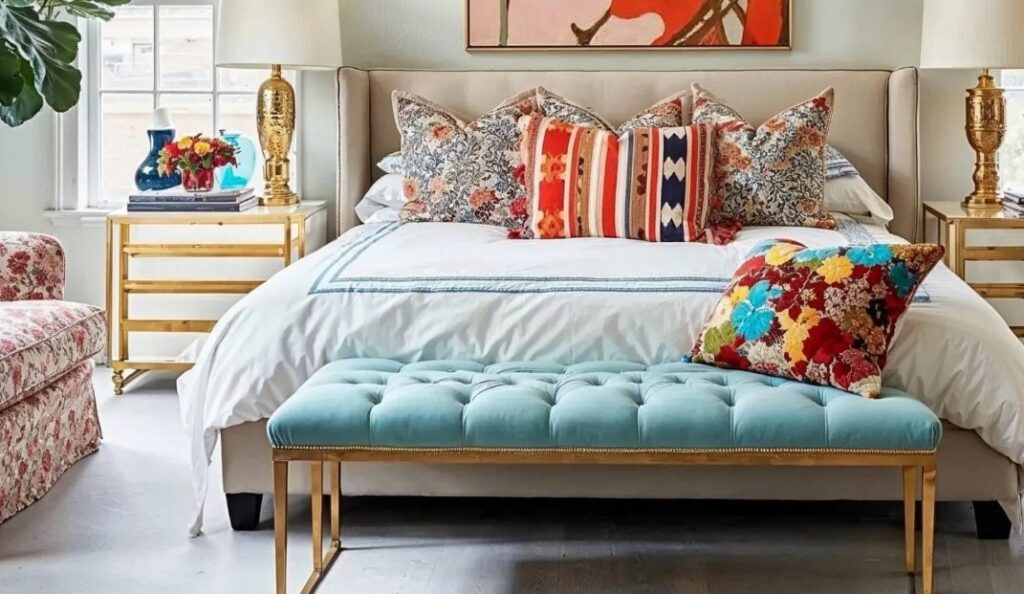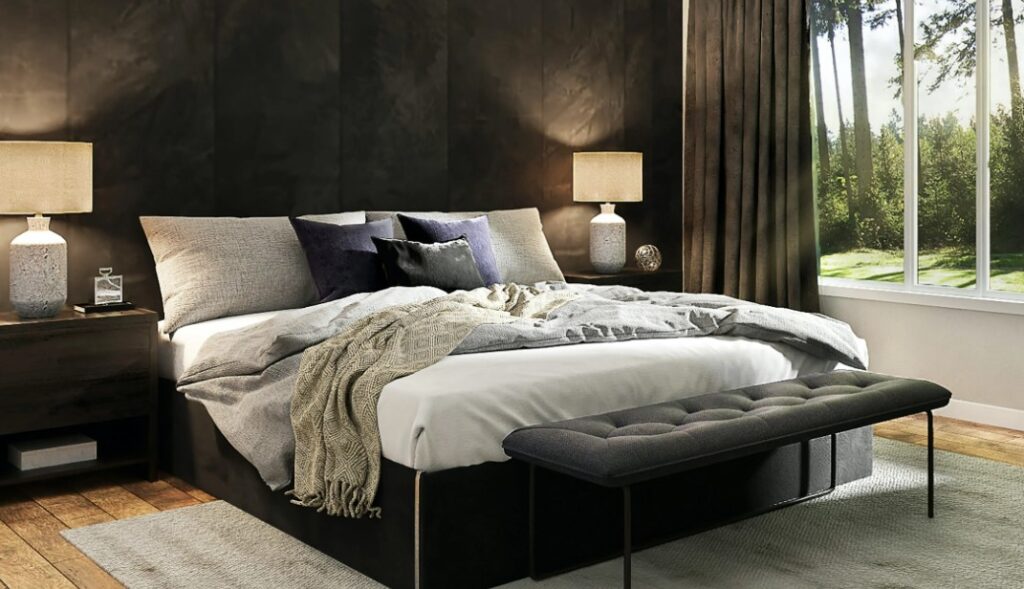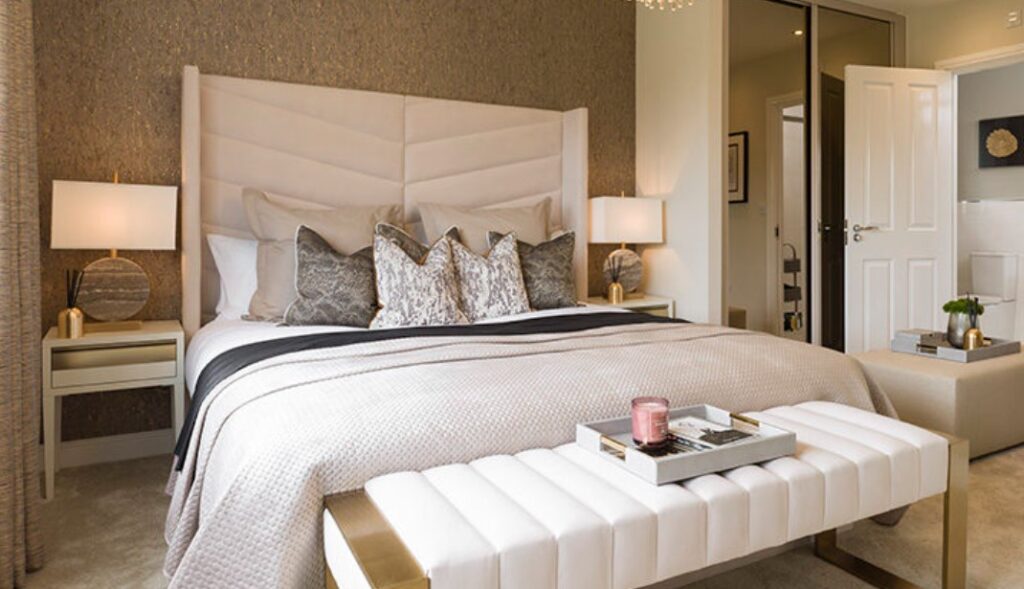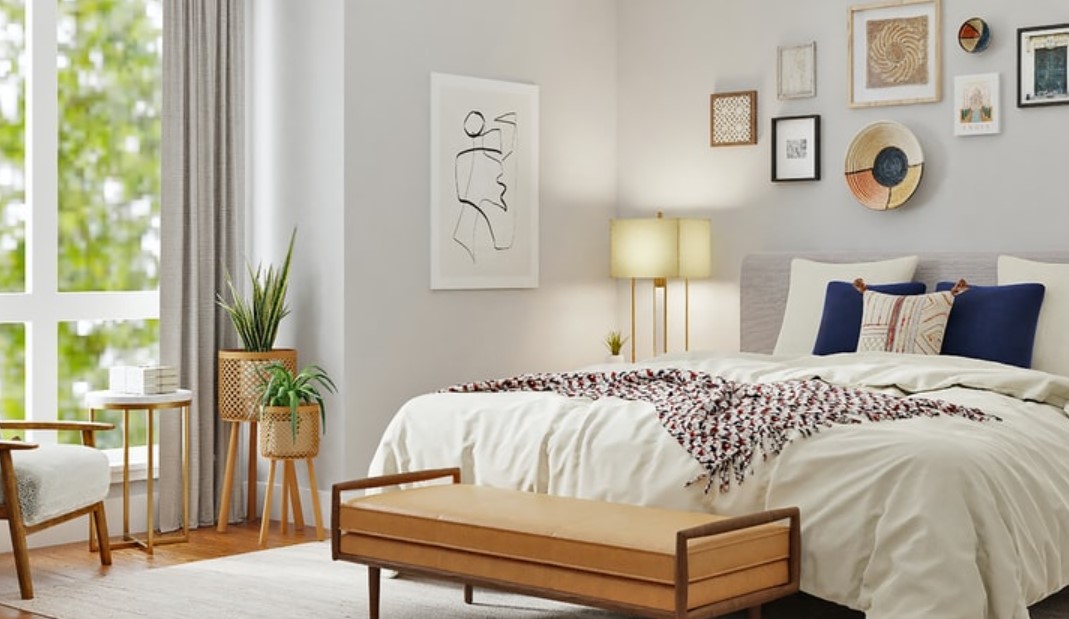Your bedroom is your sanctuary, a place to unwind, relax, and recharge. The right decor can transform this personal space into a tranquil retreat. Here, we provide a comprehensive guide on bedroom decor ideas to help you create a stylish, cozy, and inviting atmosphere.
1. Choosing a Color Scheme

Selecting the perfect color scheme for your bedroom is a crucial step in creating a space that promotes relaxation, comfort, and personal style. The right colors can transform your bedroom into a serene retreat or a vibrant sanctuary. This guide provides detailed insights into choosing the ideal color scheme for your bedroom.
Understanding Color Psychology
Color psychology is the study of how colors affect our moods and behaviors. Different colors can evoke different feelings and atmospheres, making it essential to choose hues that align with the purpose of your bedroom.
Calming Colors
For a restful and tranquil bedroom, consider calming colors such as blues, greens, and soft neutrals. Blue is known for its soothing properties and can help reduce stress and anxiety. Green, often associated with nature, brings a sense of balance and harmony. Soft neutrals like beige, ivory, and light gray can create a peaceful and elegant environment.
Energizing Colors
If you prefer a more energetic and lively bedroom, opt for colors like yellow, orange, and red. Yellow can bring a cheerful and uplifting vibe, while orange adds warmth and enthusiasm. Red, being a stimulating color, can inject passion and energy into the room. However, it’s important to use these colors sparingly to avoid overwhelming the space.
Choosing a Color Palette
When selecting a color scheme, it’s beneficial to start with a color palette that includes a primary color, secondary colors, and accent colors. This approach ensures a balanced and cohesive look.
Primary Color
The primary color is the dominant hue in your bedroom and will be used on the largest surfaces, such as the walls. Choose a color that sets the desired tone for the room. For a calm and serene bedroom, consider light blues or soft grays. For a more vibrant space, you might opt for a bold shade like teal or coral.
Secondary Colors
Secondary colors should complement the primary color and be used on medium-sized elements, such as bedding, curtains, and furniture. These colors should work harmoniously with the primary color to create a unified look. For instance, if your primary color is a soft blue, secondary colors might include shades of white, beige, or light green.
Accent Colors
Accent colors are used sparingly to add pops of interest and contrast. These can be bolder hues that draw attention to specific areas or decorative items. Accent colors can be incorporated through throw pillows, artwork, rugs, and accessories. For example, if your primary color is neutral, vibrant accents like mustard yellow or deep navy can add visual interest.
Considering Lighting
Lighting plays a crucial role in how colors appear in your bedroom. Natural light, artificial light, and the direction of light sources can all influence the perception of color.
Natural Light
Rooms with ample natural light can handle darker or more saturated colors, as the light will prevent the space from feeling too closed in. North-facing rooms tend to have cooler light, which can enhance cool tones like blue and green. South-facing rooms receive warmer light, which can make warm colors like yellow and red appear more vibrant.
Artificial Light
The type of artificial lighting you use can also impact color perception. Warm white bulbs can enhance warm tones, while cool white bulbs can make cool tones more prominent. Consider the color temperature of your lighting when choosing your color scheme.
Testing Colors
Before committing to a color scheme, it’s wise to test the colors in your bedroom. Purchase sample paints and apply them to small sections of your walls. Observe how the colors look at different times of the day and under various lighting conditions. This step ensures you’re satisfied with the colors before making a final decision.
Incorporating Patterns and Textures
In addition to color, patterns and textures can add depth and interest to your bedroom design. Mixing patterns, such as stripes, florals, and geometrics, can create a dynamic look. Incorporating different textures, such as velvet, linen, and wood, can enhance the tactile experience of the room and add visual variety.
Choosing the right color scheme for your bedroom is a pivotal aspect of creating a space that reflects your personality and meets your needs for relaxation and rejuvenation. By understanding color psychology, selecting a cohesive color palette, considering lighting, testing colors, and incorporating patterns and textures, you can design a bedroom that is both beautiful and functional.
2. Selecting the Right Furniture

Before selecting furniture, it’s crucial to assess your space. Measure the dimensions of your bedroom to understand what size furniture will fit comfortably. Consider the layout and identify the focal points, such as windows, doors, and architectural features. This will help you determine the best placement for each piece of furniture.
Room Size and Layout
The size of your bedroom will significantly influence your furniture choices. In a small bedroom, opt for pieces that maximize space without overcrowding the room. Multifunctional furniture, such as a bed with storage drawers or a compact nightstand, can be highly beneficial. In a large bedroom, you have more flexibility to incorporate additional pieces like a sitting area or a vanity.
Traffic Flow
Ensure there is enough space to move around comfortably. Plan for clear walkways, especially around the bed and main pathways. Avoid placing large pieces of furniture in high-traffic areas to prevent a cramped feeling.
Choosing Essential Furniture Pieces
Bed
The bed is the centerpiece of any bedroom. Choose a bed that fits your needs and complements your style. Consider the following factors:
- Size: Select a bed size that fits your space and your requirements. Common sizes include twin, full, queen, king, and California king. Ensure there is enough room to move around the bed comfortably.
- Style: The bed frame should match the overall design theme of your bedroom. Options range from classic wooden frames to modern upholstered beds.
- Storage: For added functionality, consider a bed with built-in storage options, such as drawers or a lift-up mattress.
Nightstands
Nightstands are essential for convenience and style. They provide a surface for lamps, alarm clocks, and personal items. When selecting nightstands:
- Height: Ensure the height of the nightstand is compatible with your bed height for easy access.
- Storage: Choose nightstands with drawers or shelves for additional storage.
- Design: Match the nightstand style with your bed and other bedroom furniture for a cohesive look.
Dresser
A dresser is important for storing clothing and other personal items. Consider the following when selecting a dresser:
- Size and Capacity: Choose a dresser that fits your storage needs and the available space. Ensure it has enough drawers to accommodate your clothing.
- Style: The dresser should complement the bed and other furniture. Options include traditional wooden dressers, modern designs, and vintage pieces.
- Functionality: Consider features such as drawer dividers, jewelry trays, and mirrors.
Wardrobe/Closet
If your bedroom lacks built-in closets, a wardrobe or armoire can provide essential storage space for clothing, shoes, and accessories. When selecting a wardrobe:
- Size: Ensure it fits your storage needs and the available space.
- Organization: Look for features like hanging rods, shelves, and drawers for efficient storage.
- Style: Match the wardrobe with your other bedroom furniture.
Seating
In larger bedrooms, adding seating can enhance comfort and functionality. Options include:
- Accent Chairs: A stylish accent chair can provide a cozy reading nook.
- Bench or Ottoman: Placed at the foot of the bed, a bench or ottoman can offer additional seating and storage.
Material and Quality
The material and quality of your bedroom furniture are crucial for durability and aesthetics. Choose materials that match your style and budget. Common materials include:
- Wood: Offers a classic and timeless look. Solid wood furniture is durable but can be expensive. Veneer or composite wood options are more affordable.
- Metal: Provides a modern and sleek appearance. Metal beds and furniture are typically durable and can be more affordable.
- Upholstered: Adds softness and luxury to the bedroom. Upholstered beds and furniture can be more comfortable but may require more maintenance.
3. Creating Ambiance with Lighting

Layered Lighting
Layered lighting is key to creating the right ambiance. Combine ambient lighting (such as ceiling lights) with task lighting (like bedside lamps) and accent lighting (such as wall sconces or fairy lights). Dimmer switches can also help adjust the mood from bright and energetic to soft and relaxing.
Statement Lighting Fixtures
Consider adding a statement chandelier or a unique pendant light to serve as a focal point. These fixtures can add a touch of glamour and sophistication to your bedroom decor.
4. Adding Texture and Patterns

Luxurious Textiles
Incorporate luxurious textiles like velvet, silk, or high-thread-count cotton for a touch of opulence. Layer your bed with plush pillows, cozy throws, and an elegant duvet to create a sumptuous sleeping environment.
Mixing Patterns
Mixing patterns can add visual interest and depth to your bedroom. Combine stripes, florals, and geometrics in complementary colors to create a harmonious look. Ensure you balance bold patterns with more subdued ones to avoid overwhelming the space.
5. Incorporating Artwork and Personal Touches
Choosing Art Pieces
Select artwork that resonates with you and complements your bedroom’s color scheme and style. Whether it’s a large painting above the bed or a gallery wall of smaller pieces, art can add personality and character to your space.
Personal Memorabilia
Incorporate personal touches such as family photos, travel souvenirs, or cherished mementos. These items make your bedroom uniquely yours and can evoke happy memories, adding to the room’s overall comfort and warmth.
6. Bringing in Nature
Houseplants for a Fresh Touch
Houseplants can enhance your bedroom’s air quality and add a touch of nature. Choose low-maintenance plants like snake plants, peace lilies, or pothos, which thrive in low light and require minimal care. Hanging planters, potted plants on nightstands, or a statement plant in a corner can bring life to your decor.
Natural Materials
Incorporate natural materials such as wood, rattan, or stone to add warmth and texture. A wooden bed frame, a rattan chair, or a stone accent wall can create a cozy and inviting atmosphere.
7. Creating a Cozy Reading Nook
Comfortable Seating
A reading nook can be a delightful addition to your bedroom. Choose a comfortable chair or chaise lounge, paired with a soft throw blanket and plush pillows. This dedicated space can be a perfect spot for relaxation and unwinding with a good book.
Adequate Lighting
Ensure your reading nook has adequate lighting. A floor lamp or a table lamp with a warm glow can create an inviting ambiance, making it a cozy retreat within your bedroom.
8. Utilizing Mirrors for Space and Light
Strategic Placement
Mirrors can make your bedroom feel larger and brighter by reflecting natural light. Place a large mirror opposite a window to maximize light reflection, or use mirrored furniture to add a touch of glamour while enhancing the sense of space.
Decorative Mirrors
Choose decorative mirrors with unique frames that complement your decor style. An ornate mirror can serve as a focal point, while a group of smaller mirrors can create an interesting visual display.
9. Designing a Feature Wall
Accent Walls
An accent wall can add drama and interest to your bedroom. Use a bold paint color, patterned wallpaper, or textured materials like wood or brick to create a striking focal point. Ensure the design complements the rest of the room for a cohesive look.
Headboard Wall
Highlight the wall behind your bed by using it as a feature wall. This can be achieved with a dramatic headboard, a large piece of art, or a unique wall treatment. This draws attention to the bed, emphasizing its role as the centerpiece of the room.
10. Enhancing Comfort with Rugs
Choosing the Right Rug
A rug can add warmth, comfort, and style to your bedroom. Choose a rug that complements your color scheme and is large enough to extend beyond the sides of your bed. Soft, plush rugs can create a cozy feel, while patterned or textured rugs can add visual interest.
Layering Rugs
Layering rugs can create a more dynamic and comfortable look. Combine different textures and patterns to add depth to your decor. For example, place a smaller, patterned rug over a larger, neutral rug to create a unique and inviting space.
By incorporating these bedroom decor ideas, you can create a space that is not only stylish but also a true reflection of your personality. Your bedroom should be a haven of comfort and tranquility, a place where you can relax and recharge.
